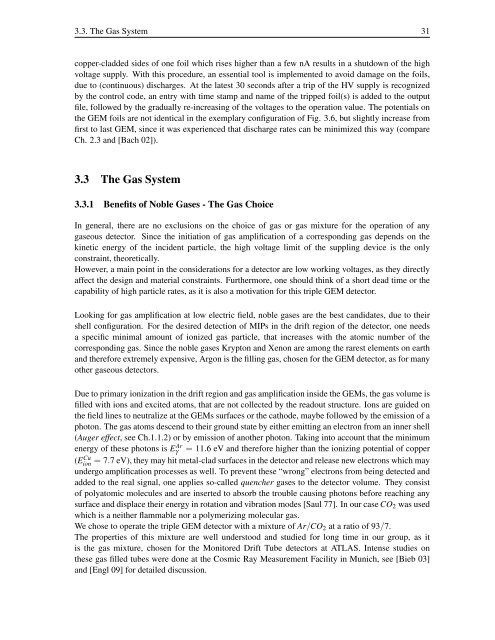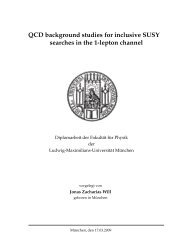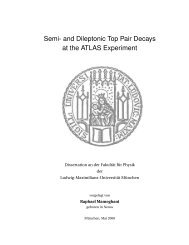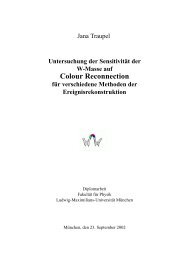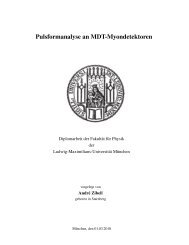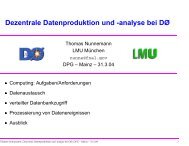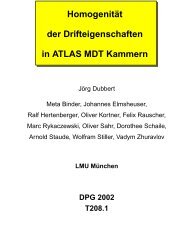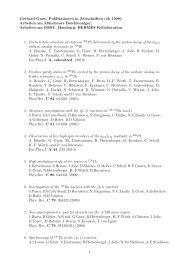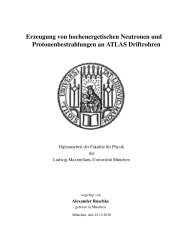development of micro-pattern gaseous detectors – gem - LMU
development of micro-pattern gaseous detectors – gem - LMU
development of micro-pattern gaseous detectors – gem - LMU
You also want an ePaper? Increase the reach of your titles
YUMPU automatically turns print PDFs into web optimized ePapers that Google loves.
3.3. The Gas System 31<br />
copper-cladded sides <strong>of</strong> one foil which rises higher than a few nA results in a shutdown <strong>of</strong> the high<br />
voltage supply. With this procedure, an essential tool is implemented to avoid damage on the foils,<br />
due to (continuous) discharges. At the latest 30 seconds after a trip <strong>of</strong> the HV supply is recognized<br />
by the control code, an entry with time stamp and name <strong>of</strong> the tripped foil(s) is added to the output<br />
file, followed by the gradually re-increasing <strong>of</strong> the voltages to the operation value. The potentials on<br />
the GEM foils are not identical in the exemplary configuration <strong>of</strong> Fig. 3.6, but slightly increase from<br />
first to last GEM, since it was experienced that discharge rates can be minimized this way (compare<br />
Ch. 2.3 and [Bach 02]).<br />
3.3 The Gas System<br />
3.3.1 Benefits <strong>of</strong> Noble Gases - The Gas Choice<br />
In general, there are no exclusions on the choice <strong>of</strong> gas or gas mixture for the operation <strong>of</strong> any<br />
<strong>gaseous</strong> detector. Since the initiation <strong>of</strong> gas amplification <strong>of</strong> a corresponding gas depends on the<br />
kinetic energy <strong>of</strong> the incident particle, the high voltage limit <strong>of</strong> the suppling device is the only<br />
constraint, theoretically.<br />
However, a main point in the considerations for a detector are low working voltages, as they directly<br />
affect the design and material constraints. Furthermore, one should think <strong>of</strong> a short dead time or the<br />
capability <strong>of</strong> high particle rates, as it is also a motivation for this triple GEM detector.<br />
Looking for gas amplification at low electric field, noble gases are the best candidates, due to their<br />
shell configuration. For the desired detection <strong>of</strong> MIPs in the drift region <strong>of</strong> the detector, one needs<br />
a specific minimal amount <strong>of</strong> ionized gas particle, that increases with the atomic number <strong>of</strong> the<br />
corresponding gas. Since the noble gases Krypton and Xenon are among the rarest elements on earth<br />
and therefore extremely expensive, Argon is the filling gas, chosen for the GEM detector, as for many<br />
other <strong>gaseous</strong> <strong>detectors</strong>.<br />
Due to primary ionization in the drift region and gas amplification inside the GEMs, the gas volume is<br />
filled with ions and excited atoms, that are not collected by the readout structure. Ions are guided on<br />
the field lines to neutralize at the GEMs surfaces or the cathode, maybe followed by the emission <strong>of</strong> a<br />
photon. The gas atoms descend to their ground state by either emitting an electron from an inner shell<br />
(Auger effect, see Ch.1.1.2) or by emission <strong>of</strong> another photon. Taking into account that the minimum<br />
energy <strong>of</strong> these photons is EAr γ = 11.6 eV and therefore higher than the ionizing potential <strong>of</strong> copper<br />
(ECu ion = 7.7 eV), they may hit metal-clad surfaces in the detector and release new electrons which may<br />
undergo amplification processes as well. To prevent these “wrong” electrons from being detected and<br />
added to the real signal, one applies so-called quencher gases to the detector volume. They consist<br />
<strong>of</strong> polyatomic molecules and are inserted to absorb the trouble causing photons before reaching any<br />
surface and displace their energy in rotation and vibration modes [Saul 77]. In our case CO2 was used<br />
which is a neither flammable nor a polymerizing molecular gas.<br />
We chose to operate the triple GEM detector with a mixture <strong>of</strong> Ar/CO2 at a ratio <strong>of</strong> 93/7.<br />
The properties <strong>of</strong> this mixture are well understood and studied for long time in our group, as it<br />
is the gas mixture, chosen for the Monitored Drift Tube <strong>detectors</strong> at ATLAS. Intense studies on<br />
these gas filled tubes were done at the Cosmic Ray Measurement Facility in Munich, see [Bieb 03]<br />
and [Engl 09] for detailed discussion.


